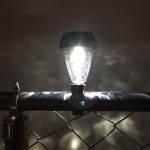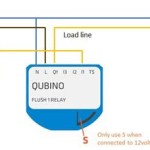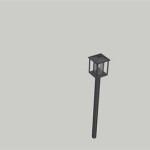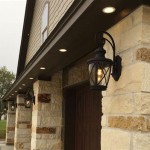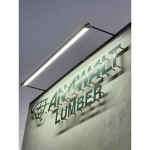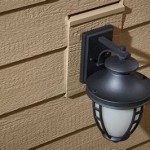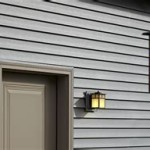Outdoor Floodlights vs. Spotlights: Understanding the Differences for Optimal Outdoor Lighting
Effective outdoor lighting enhances safety, security, and aesthetics. Two common options for achieving these goals are floodlights and spotlights. While both illuminate outdoor spaces, they differ significantly in their design, function, and optimal applications. Understanding these distinctions is crucial for selecting the right lighting solution for a specific need.
Floodlights are designed to cast a broad, diffused light across a wide area. This is achieved through a wide beam angle, typically ranging from 120 degrees or more. The resulting illumination is generally even and less intense than that provided by spotlights. This makes floodlights suitable for general area lighting, where the goal is to illuminate a large space without harsh shadows or overly bright spots.
Spotlights, in contrast, are designed to produce a focused, concentrated beam of light. Their beam angles are much narrower, often ranging from 45 degrees down to just a few degrees. This allows for the light to be directed at a specific object or area, highlighting details or creating a dramatic effect. Spotlights are characterized by their higher intensity and the distinct shadows they create.
Key Point 1: Beam Angle and Coverage Area
The fundamental difference between floodlights and spotlights lies in their beam angle and the resulting coverage area. A floodlight's wide beam angle allows it to illuminate a larger area with a relatively even distribution of light. This is ideal for lighting entire yards, driveways, or building facades. The light produced is less intense, making it less likely to cause glare or harsh shadows.
A spotlight's narrow beam angle, on the other hand, concentrates light onto a smaller area. This concentrated light is much more intense than that of a floodlight, making it suitable for highlighting specific features such as architectural details, landscaping elements, or security-sensitive areas. The directed nature of a spotlight beam allows for precise control over where the light falls.
Consider a homeowner wanting to illuminate their entire backyard. A floodlight would be a more appropriate choice, as it would provide broad, even illumination across the entire space. Alternatively, if the homeowner wanted to highlight a specific tree or statue in their yard, a spotlight would be the preferred option, as it would allow them to focus the light precisely on that feature.
The choice between a floodlight and a spotlight depends heavily on the size of the area to be illuminated and the desired effect. Larger areas benefit from the broad coverage of a floodlight, while smaller, more specific areas benefit from the focused intensity of a spotlight.
Key Point 2: Intensity and Purpose
The intensity of the light emitted and the intended purpose of the lighting are also key factors in determining whether a floodlight or a spotlight is more suitable. Floodlights, with their diffused light, are often used for security purposes, providing general illumination that deters potential intruders. They are also commonly used for recreational purposes, such as lighting a patio or deck for outdoor gatherings.
The lower intensity of floodlights compared to spotlights makes them less likely to cause glare or discomfort, making them suitable for areas where people will be spending time. The even distribution of light also reduces the likelihood of creating harsh shadows, which can be disorienting or make it difficult to see clearly.
Spotlights, with their higher intensity and focused beam, are often used for security purposes as well, but in a different way. They can be used to highlight specific areas that are vulnerable to intrusion, such as doorways, windows, or fence lines. The intense light can also be used to startle or disorient potential intruders.
Spotlights are also commonly used for aesthetic purposes, such as highlighting architectural features or landscaping elements. The focused beam allows for precise control over the lighting effect, creating dramatic shadows and highlighting specific details. This makes spotlights ideal for creating visual interest and enhancing the overall appearance of a property.
Therefore, choosing the correct light depends on the desired illumination level and function. Low level area lighting benefits from floodlights, while objects requiring precise high-intensity illumination benefit from spotlights.
Key Point 3: Installation and Energy Consumption
Installation considerations and energy consumption are practical factors that should be taken into account when choosing between floodlights and spotlights. Floodlights, with their wider coverage area, may require fewer fixtures to illuminate a given space compared to spotlights. This can simplify the installation process and reduce the overall cost.
However, floodlights typically require higher wattage bulbs to produce the necessary level of illumination. This can result in higher energy consumption compared to spotlights, especially if the floodlights are left on for extended periods. Choosing energy-efficient LED floodlights can help to mitigate this issue.
Spotlights, with their focused beam, may require more fixtures to achieve the desired level of illumination in a larger area. This can increase the complexity and cost of the installation process. However, spotlights typically use lower wattage bulbs compared to floodlights, as the light is concentrated into a smaller area.
This can result in lower energy consumption, especially if LED spotlights are used. Furthermore, the ability to precisely control the direction of the spotlight beam can help to minimize light pollution and ensure that light is only directed where it is needed.
The choice between floodlights and spotlights should also consider the specific mounting location and the type of wiring available. Floodlights are often mounted on walls, eaves, or poles, while spotlights can be mounted on a wider variety of surfaces, including trees, statues, or even underground. It is essential to ensure that the chosen lighting fixture is suitable for the intended mounting location and that the wiring is adequate to handle the electrical load.
Modern outdoor lighting options also include smart features. Both floodlights and spotlights are now available with integrated motion sensors, timers, and remote control capabilities. These features can help to improve security, conserve energy, and provide greater convenience. For example, a motion-activated floodlight can be used to deter intruders, while a timer-equipped spotlight can be used to automatically highlight landscaping features at night.
Light quality must also be considered. The color temperature can affect how comfortable and natural the light appears. Cooler temperatures (5000K and above) are typically brighter and more 'alerting,' while warmer temperatures (2700K-3000K) provide a softer, more inviting glow. For security lighting, cooler temperatures might be favored, while warmer temperatures are usually preferable for ambient lighting.
When making a decision, consulting with a lighting professional can provide expert guidance tailored to the specific needs of the property. Lighting professionals can assess the area, recommend appropriate fixtures, and ensure that the installation is done safely and effectively. They can also advise on energy-efficient options and help to optimize the lighting design for both aesthetics and functionality.
In summary, the choice between floodlights and spotlights requires considering several factors: desired coverage area, intensity needed for the intended purpose, beam angle requirements, wattage restrictions, installation considerations, color temperature to match the purpose, and any additional desired smart features. Weighing these elements carefully will result in an outdoor lighting solution that meets the property's specific needs.

Spotlight Vs Floodlight Superlightingled Com Blog

Spotlight Vs Floodlight Superlightingled Com Blog

Led Floodlight Vs Spotlight Which One Is Better Agc Lighting

Floodlight Vs Spotlight Which One Is Better

Led Floodlight Vs Spotlight Which One To Choose Rc Lighting

Spotlight Vs Floodlight Superlightingled Com Blog

What Is The Difference Between Floodlight And Spotlight Ledmyplace

Spotlight Vs Floodlight Superlightingled Com Blog

Ring Spotlight Vs Floodlight Modern Castle

Spotlights Vs Floodlights The Difference Explained Super Bright Leds
